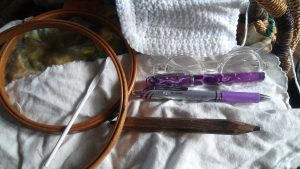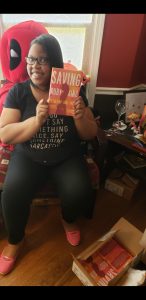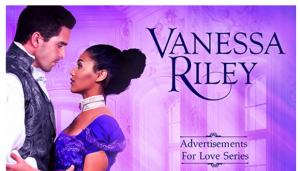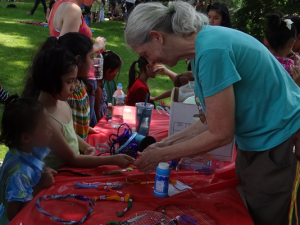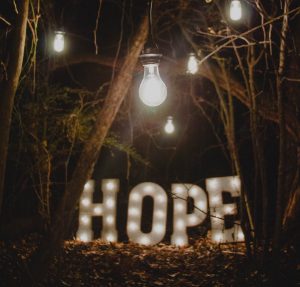Posts by Grace Wynter
The artist’s tools: From Deb Lacativa’s studio, where all the magic happens.
My first Author Up Close post for 2021 features someone many of you might already be familiar with. Deb Lacativa is not only an active member of the Writer Unboxed community, she was also the 2016 WU Conference Scholarship recipient and returned to deliver the 2018 keynote speech. Deb also reminded me that she was, in her own words, “the first sacrificial lamb to the ‘All the King’s Slaughter … I mean, All the King’s Editors’ feature on Writer Unboxed.” The story Deb submitted for that series is now complete and will be published in a few weeks.
I not only wanted to interview Deb because she’s a gifted storyteller and creator (and friend), but because from the start, Deb defined success on her own terms. When she realized her genre-bending, 800-page debut novel would likely never get buy-in from a traditional publisher, she decided to take a different route to publication. In this Q&A we learn more about the novel and the choices that led Deb on that journey. Of course, if you know Deb at all, you know her answers are filled with the same mix of magic and mayhem her stories are. And, as an added bonus, at the end of this post, there’s a special treat.
GW: Tell us a little about how your writing journey started and when you went from dreaming about becoming an author to taking actionable steps to becoming one?
DL: I’ve been writing since I figured out that crayons didn’t taste good and had a better purpose. I was surrounded by adults who frequently had their noses buried in newspapers. The headlines seemed designed for a toddler to puzzle out, so I pestered for answers because I wanted in on this grownup magic. “MOBSTER SLAIN” above a lurid black-and-white photo on the front page of the NY POST was the first sentence I ever copied. But, beyond bs-ing all my teachers with style over substance at every opportunity, it wasn’t until 2005 that I started writing for an audience on my blog: The misadventures of a textile artist. I used it to be engaging. Sometimes, downright hilarious.
Then, over the course of sixteen months starting in the summer of 2012, both my parents and my husband, Jim, passed away. By January 2014, I needed to get out of the house and be with people who did not know me. It could have been throwing pots or axes, it didn’t matter just as long as there were no condolences. Meetup offered a writer’s group not far away. “Bring a sample of your writing.” I took my turn and was immediately hooked on getting feedback, good or bad. I’d found my heart and purpose for writing. I never dreamed of becoming a published author. It became an objective. Like learning to read and write, it was a skill set that I wanted to learn.
Read MoreAuthor Catherine Adel West Unboxes her Novel, Saving Ruby King
In this installment of my Author Up Close series, I share a Q&A with debut author Catherine Adel West. Catherine and I are social media friends, and I’ve been impressed with the way she has navigated becoming a debut author during this unprecedented time. Her novel, Saving Ruby King, which Kirkus calls “a multilayered love letter to South Side Chicago’s African American faith-based community,” tackles the complex topics of faith and family and the secrets that can bind or break them.
Saving Ruby King debuts on June 16, and even in the midst of a busy launch, Catherine took the time to offer great advice to writers about making their query letters stand out, researching genres, and publishing during a pandemic.
GW: One of my favorite parts of this series is hearing author origin stories: the stories behind what propelled them from people who only thought about writing, to people who actually wrote and either queried or published a novel. What’s your author origin story?
CAW: It took me five years from beginning to end to write the rough draft of Saving Ruby King. It was the first book I ever wrote. Originally, it was a short story idea, and at a wedding I was speaking to an old college classmate, and she suggested I write a book. I had NO experience, but I had two degrees in journalism and figured how hard is it to write a book? Turns out it’s incredibly hard to write a book. Go figure!
Saving Ruby King started out as a hobby, became a passion, and soon turned into an obsession. Once I finished what I thought was the final draft (turns out I had at least 10 more versions to go), I began querying. At first, I didn’t know what I was doing, but luckily I had fantastic friends in my corner who are also writers. They helped me further hone my story and develop my query letter. One friend, Kevin Savoie, was instrumental in helping me navigate the querying process. I had many close calls with agents, including an R&R, and was feeling discouraged when I decided to again participate in #DVPit—a contest for POC/marginalized writers—in April 2018. After an offer of publication from an indie press, I notified the other agents with whom I had full manuscript requests, and Beth Marshea of Ladderbird Literary offered me rep, and I happily accepted Beth’s offer. It took me nine months to land a literary agent.
I went with Beth as she had such a passion for my story, and I knew I could always trust her to have my best interests at heart. After a round of edits, we went on submission and my book was acquired by Park Row/HarperCollins within six weeks!
From writing to publication, I’ve had astounding highs and lows, but I’m so grateful for where the journey has led me thus far.
Read MoreI’m known for asking a lot of questions. A lot of questions. Particularly of my author friends. And when I launched the Author Up Close series in 2019, my goal was to share some of their knowledge and wisdom with other writers. The series resonated with so many, I’ve decided to continue it in 2020. The information these authors share provides a unique inside look at the industry, what it often takes to break in, and helpful advice on how to handle the business on your own terms. Today’s Q&A with Regency and Historical Romance writer Vanessa Riley tackles all of that, and I’m delighted I had the opportunity to interview her.
I’ve been Facebook friends with Vanessa for years, but we only met in person when I moderated a panel discussion at the 2018 Decatur Book Festival. The panel, entitled Empowering Women with Romance: The Literature of Hope and Resistance, offered a modern, liberating take on the romance genre. One of the highlights was Vanessa sharing about the opposition she faced from some in the publishing industry regarding the viability of diverse regency stories. In my Q&A with her, she discusses how wrong these gatekeepers were, her sink or swim moment, and her recent print deal with William Morrow.
GW: You’ve got quite an interesting path-to-publishing story, particularly surrounding your serialized Christian regency saga, The Bargain. Will you share a little about what inspired you to write and publish that series yourself?
VR: My path is a little different. I’ve always been drawn to telling Regency Era stories. Faith is very important to me, so all my novels have those threads. I had been traditionally published in 2013 and acquired an agent, but no one thought there was an audience for diverse Regency stories. One look at the 10,000 to 20,000 free blacks living in London or any of England’s colonies, and you’ll see that the period is very diverse, but no traditional publisher wanted these, and I could no longer ignore the voices of those who looked like me, who lived and loved and found ways to survive.
I was at a crossroads. No publisher was going to take the risk to find this audience and prove me right. I had to do it. That was the genesis of The Bargain, a serialized tale featuring a proud African American maid who ends up sailing with her employer to the South African colony of Port Elizabeth. This was my sink or swim moment. I indie-published this novella and was surprised by the marketplace reaction. It sold over 1,000 copies in two weeks, with no advertisement or marketing other than a few posts on Twitter or Facebook. I’d proven there was a market for diverse Regencies. I also made folks hungry for more of this story. They wanted to know what happened to my characters Precious and Gareth. I had to hunker down and write. It was released in four serials because that was as fast as I could write.
Read MoreElizabeth’s marketing at work.
For my final installment of my Author Up Close series in 2019, I’m sharing a Q&A with Elizabeth Bell. Elizabeth and I e-met after both finaling in a writing award competition. Elizabeth is a craft genius—no surprise there; she has an MFA from George Mason University and works in the school’s library. When I caught up with her she was launching her novel, Necessary Sins, a James Jones First Novel Fellowship finalist. Her 26-year journey to publishing is fascinating, and our Q&A provides an honest look at the sometimes tumultuous road to publishing and how that road makes it even more important to define success on your own terms.
GW: You’ve got an interesting backstory when it comes to writing Necessary Sins, including how long you spent working on it. Will you share what inspired you to write about this particular subject?
DB: When I was eight years old, I visited Charleston, South Carolina. I fell in love with its gardens and architecture and wanted to set a story there. As an adolescent, I devoured Colleen McCullough’s The Thorn Birds, John Jakes’s North and South, and Alex Haley’s Roots. I wanted to write a saga on that scale, something with multiple settings that would follow characters across decades. Those stories are great escapism and drama, but they also taught me about history and place.
The central family in my saga, the Lazares, is multiracial and “passing.” This was partially about secrets—family sagas always revolve around those—and partially about history, getting at the heart of the contradictions that are the American Dream. But the very first seed of the Lazares’ racial makeup came from my mother. She read an early draft and told me Caucasian people don’t have black hair; it would have to be dark brown. But my Lazares had black hair; I just knew it! Caucasian people do have black hair—the Welsh, for instance—but somehow the “problem” of black hair simmered in the back of my mind. I was puzzling out David’s (one of the main characters) personality, what made him reluctant to trust and reveal his true self, as well as why his uncle Joseph might choose to become a celibate priest. Joseph is very pious, but as a priest, he’s also hiding in plain sight. My characters are products of their time, but I wanted them to resist racism. What might make them view the world differently than the slaveholders around them and work for justice? My answers to these questions coalesced into the Lazare family having African ancestry.
It’s taken me a quarter-century of research and revision to become a wise enough person and good enough writer to tell this story.
GW: You went to great lengths to authentically portray characters with African ancestry. Will you share some of the things you did to help with that?
Read MoreAuthor Anne O’Brien making friendship bracelets.
In this week’s Author Up Close, I interview Anne O’Brien Carelli, author of adult nonfiction, the middle-grade book Skylark and Wallcreeper, and the picture book Amina’s New Friends. She’s been a friend and mentor since we met at our first Writer Unboxed conference. Anne is the owner of a leadership training business, and she has taught me invaluable lessons about managing the craft and business sides of being a writer. Her advice will be especially helpful to anyone writing and querying middle-grade or YA fiction, and she’s a great example of using the skills you’ve learned in previous careers in your career as a writer.
GW: How did you find your agent and land your publishing deal?
AOBC: I had published two nonfiction adult books and self-published a picture book, but the children’s traditional publishing world was new to me. I soon discovered that writers who want to publish a children’s book need to have perseverance, blind optimism, a desire to hone the craft, and a belief in serendipity. It also helps to pay close attention to what is published in your genre.
I found my agent by chance. As I was researching an editor I admired at a conference, I came across a description of her colleague, who looked like the perfect match for my middle-grade book, Skylark and Wallcreeper. I had rewritten my query a million times, but tried again.
I think it’s really important to investigate what agents like to read, what they are looking for, and what types of books they have represented in the past. You can learn a lot of this information by attending conferences and signing up for short consultations with individual editors and agents.
As for landing the publishing deal? I give my agent all of the credit for that. She also looked for the right match and Little Bee Books has been a wonderful home for my book.
GW: Why did you decide to write middle-grade fiction, and why this subject matter?
AOBC: There was never any doubt that I would eventually write middle-grade fiction. The picture book was written because I have volunteered with refugee children for many years and saw that the story about a refugee girl’s first day in an American school was desperately needed. The textbooks I published were related to my work in gender equity and leadership. But many eons ago I taught sixth grade and social studies, and middle grade is my favorite age group (ages 8-12). Those kids are just on the cusp of figuring out who they are, and are developing independence and coping skills. middle-grade books, especially in the last two or three years, address a number of tough issues that kids are facing today. But every middle-grade book has hope at the end, and that appeals to me.
Read MoreAuthor Roger Johns
So far in my Author Up Close series, you’ve met Fiona Zedde, an author whose hybrid approach to publishing has allowed her to live and work anywhere in the world and Linda Seed, a self-publishing success story who made more from a single ad placement than many authors make in their entire careers.
Today I’m sharing my Q&A with Roger Johns, whose debut novel, Dark River Rising, was eleven years in the making and who is one of the smartest and hardest working authors I know. Roger received an offer from a publisher before he even had an agent, and today he shares wonderful insights into balancing the craft and business sides of writing, the importance of being honest with yourself about your work, and the five things he did that helped his manuscript—and that may help yours—stand out among hundreds of others.
GW: I’m a fan of origin stories, and though the term is usually only used to describe superheroes, I love to use the term with published authors. What’s your writer-to-published-author origin story for your debut novel, Dark River Rising?
RJ: The idea for my first book came to me, out of the blue, in the spring of 2006. Even though I was focused on other matters back then, I toyed with the idea, made occasional notes, and periodically announced to my wife that I was writing a novel. But, it wasn’t until I realized that an idea for a book was not the same as a plot that writing the book seemed possible. This was the first of several critical realizations.
In the fall of 2008, I met Atlanta author, David Fulmer. With some elbowing from my wife, I let it slip that I had this idea for a book but I didn’t know what to do with it. The winter iteration of David’s writing workshop for beginners was starting soon, so I signed up. I learned a lot, but I still had problems.
Not until I realized the book should be about how a person experienced a world shaped by my idea, and not about the idea itself, did the path forward open up. This was the critical turning point. Still, I never got past page seventy-five or eighty.
In desperation, I changed my male main character’s age, job, history, and mission, but nothing worked. Then, some of that little-voice-in-the-back-of-my-head magic told me to audition a woman for the lead role. Immediately, I realized: (1) I should do this, and (2) I have no idea how to do this.
In the fall of 2013, I joined my first critique group. Over the next eighteen months, I joined and left four groups, learning from each how to solve a specific problem. I also completed a first draft, finished several rewrites, made my original idea the fundamental driver of the story, and learned to write a female character with a degree of authenticity.
All the while, I was cold-querying agents and attending conferences, trying to sell the book. In May 2015, an editor at St. Martin’s Press, who had critiqued my first 20 pages at a conference, asked to see the whole book. In June, after using her feedback as a […]
Read MoreCambria, California
Welcome to the second installment of Author Up Close, the series that explores several authors’ paths to publishing. If you missed the first in the series, a Q&A with author Fiona Zedde, you can read it here.
There are probably as many articles about the perils of self-publishing as there are about the “fall” of traditional publishing. Most of these articles lack nuance and are more concerned with promoting a perceived “right” way to publish while disparaging the “wrong” way. In reality, choosing a publishing path is a very personal decision, and what’s right for one might not be right for others.
Today’s featured author, Linda Seed, obviously made the right choice for herself and her career when she decided to self-publish. Linda is a contemporary romance writer, a Writer Unboxed Conference alum, and a friend. We’re in a few online communities together, and over the years I’ve watched her career grow from an author who, in her words, “made enough to buy a coffee” to one who now makes a living from her books.
In a sea of self-published authors, Linda stands out because of her excellent writing, commitment to quality, and strong work ethic. And as you’ll see from our Q&A, those things probably had a hand in getting Barnes & Noble’s attention at just the right time in her career.
GW: What do you write and how many books have you published?
LS: I write small-town contemporary romance, with all of my books set on California’s Central Coast. I’ve published nine books so far.
GW: You’re doing what a lot of other authors wish they could be doing right now: making a full-time income from your writing. When you started writing, had this been your goal? If not, when and what changed that?
LS: Honestly, when I started, I didn’t expect to make any money at all. It was more of a bucket list thing—I wanted to have a published book out there. For me, the day I uploaded my first book onto Amazon, my goal was met. Anything else was just a bonus.
Things changed eleven months later, in September 2016. I had two more books out by then, and I had just made my first book free. I went onto Facebook one morning to find a bunch of notifications from friends congratulating me. I learned that Barnes & Noble had featured my first book as their Free Fridays pick. My book was all over their social media, on their website—it was crazy. That drove the sales of my other books, and overnight I was making ten times more money than I had been. That was when I thought, okay, I might be able to make this into a viable business. I still have no idea why they chose my book, but that was really a turning point for me.
Read MorePhoto by Marcos Luiz Photograph on Unsplash
Though you may not know it by the prevalence of clickbait headlines sounding the death knell about author careers, successful authors are out there. Lots of them. And I’m not just talking about the ones who top the bestseller lists week after week. I’m talking about the authors whose names you may have never heard, who are quietly writing and earning income from their books.
And while there is no formula for becoming a successful author, or even a consensus about what defines “success,” there is much that can be learned from studying authors who are already where we hope to be one day. I’m fortunate to know several of these authors. I’ve had the benefit of their wisdom and expertise for years and wanted to share some of that wisdom with you. So this year, in my posts for Writer Unboxed, I’ll be sharing Q&A’s from authors I think we can all learn from.
My series, Author Up Close, will include Q&A’s with two of Writer Unboxed’s own: Anne O’ Brien Carelli, whose middle-grade novel was published by Little Bee in 2018; and Linda Seed, a contemporary romance author who had so much success self-publishing, she was able to leave her 9-5 to write full time. The series will also include interviews with Roger Johns, a traditionally published author who found himself in the enviable position of having to find an agent after being offered a publishing deal, and Vanessa Riley, a Ph.D. in mechanical engineering who writes multi-cultural Regency and historical romances in an industry that (falsely) believed there wouldn’t be a large enough audience for her work.
Author Up Close begins with a Q&A with Fiona Zedde. Fiona is the author of several novellas and novels including the Lambda Literary Award finalist Bliss. Her novel, Dangerous Pleasures, won the About.com Readers’ Choice Award for Best Lesbian Novel or Memoir of 2012. Fiona lives a location-independent lifestyle, traveling and sometimes living abroad for months at a time. As you’ll discover from our Q&A, her ability to adapt to changes in the industry has been key to her success as an author.
GW: You’re what the publishing industry considers a “hybrid author.” Was this an intentional strategy you adopted when you first launched your professional writing career or is this something that evolved?
Read MorePhoto by Ron Smith on Unsplash
I’ve been thinking about hope a lot lately. As it pertains to the world in general and writers in particular. Even the most cynical among us hold out hope for something. Hope is what gets us up in the morning. It compels us to keep working on our manuscripts for years. It whispers to us to reactivate that OKCupid dating profile. For the tenth time. Because maybe this time will be different. (Spoiler alert: it wasn’t.)
But sometimes hope can feel like a “kick me” sign you’ve pinned to your own back. A few years trying (and often failing) to crack this industry is all it takes for many of us to begin losing hope that our work will ever succeed. So what’s a writer to do? How do we hold the hope of getting an agent, or publishing a bestselling novel, or making a living as a writer, up to the harsh reality that over 96% of manuscripts are rejected, and most self-published books never sell over 150 copies?
The answer is, it’s a balancing act.
Without hope, we would stop submitting to agents, we’d never self-publish, and we wouldn’t retreat into our writer spaces and create the words, day in and day out. But we’ve also come to understand that perseverance, discipline, and hard work are all part of the reality of what we do. So while hope might be the thing that first inspires us to get behind our keyboards, understanding the reality of this business is what keeps us there.
Hope gives us enough fortitude to submit to a new round of agents or contests.
Reality reminds us to spend a little more time honing our craft before we submit.
Hope makes us look on in awe at authors like Angie Thomas and Andy Weir, and cross our fingers and toes that maybe our novels will be received as well and as widely as theirs were.
Reality teaches us
Read MoreI know my lease is up and the bailiff’s at the door
And still I’m hanging on to the life we had before
“Chainsmoking”—Jacob Banks
I listen to white noise or instrumental music when I write because I usually find silence and music lyrics distracting. But there are times when a song’s lyrics allow me to discover things about my story I’d previously been unable to see.
At a recent writing retreat, I vowed to shake things up and break through the writer’s block I’d been experiencing with my WIP. Part of that shakeup involved excessive snacking. Surprisingly (or not), competitive snacking didn’t trigger the breakthrough. Listening to music—specifically, Jacob Banks’s “Chainsmoking” on repeat—did.
Banks’s gritty, guttural sound and spot-on lyrics so clearly captured the dynamic of my protagonist’s volatile relationship with her ex, their story began unfolding before my ears. A few hours later, I had written over 6,000 words. Many of those words are backstory that will never make it to the page, but that backstory will be the thread that runs through my characters’ emotional arcs.
That breakthrough led me to create multiple soundtracks for my WIP. I’ve created writing soundtracks before, but they’d been general “writing motivation” playlists, or I’d created them after my story was complete. This time I used the soundtracks as tools to break my writer’s block. In the process, I discovered new layers to my story. Even if you’re a diehard “silence writer” creating soundtracks might help if you’re experiencing writer’s block.
Soundtrack Your Scenes and Chapters
Characters aren’t the only things that should convey emotions; scenes and chapters should, too. When selecting a song(s) for your chapter soundtrack, think about the many words we use to describe music; soaring, thumping, uplifting, exhilarating, soulful, mournful, and sensual, to name a few. Emotionally, where does your scene start, and where does it end? Is there a song or lyric that perfectly describes your chapter’s mood? When you find that song, submerge yourself in the atmosphere it creates and allow the emotions to flow through to your writing.
Television gets a bad rap. Some of it is deserved—I’m looking at you Sharknado—but some of it comes by way of the rarified air some writers breathe. You know the air; it smells a little like antique books and pretension. It’s the air that convinces some of us that if the masses consume it, it can’t be any good.
Sharknado notwithstanding, there is good television out there. There are widely-known, critically acclaimed shows like Game of Thrones and Breaking Bad, and there are lesser known shows, some long-canceled, like Firefly and A Different World, that changed the way viewers engaged with each other and the world. What these shows have in common is their ability to entertain, and we can learn a lot about writing—and our writing careers—from studying them. In an effort to keep this post from being the length of a novel, I’ve focused on a showrunner, two shows, and commercial breaks to provide examples of how television can inform the way authors write and share stories.
1) Shonda Rhimes and the power of a recognizable brand
If you’ve watched anything on ABC over the past few years, you’re probably familiar with Shonda Rhimes. Her shows, Grey’s Anatomy, Scandal, and How To Get Away with Murder, have been rating powerhouses for ABC, reshaping the network’s evening lineup. But what we can learn from Shonda extends beyond powerful writing. If Shondaland, Rhimes’s production company, is associated with a project, viewers know to expect strong but flawed female leads, a diverse cast, and soap opera-like drama. This is Shonda’s brand on ABC, and she delivers it faithfully to her dedicated fans. Know your audience, create what they enjoy, brand it, and repeat.
2) The West Wing and characters we care about
This Golden Globe and Emmy Award winning TV show is a master class on pacing, dialogue, and creating characters people care about. Here’s a scene that accomplishes all three.
- « Previous
- 1
- 2
- 3
- Next »

